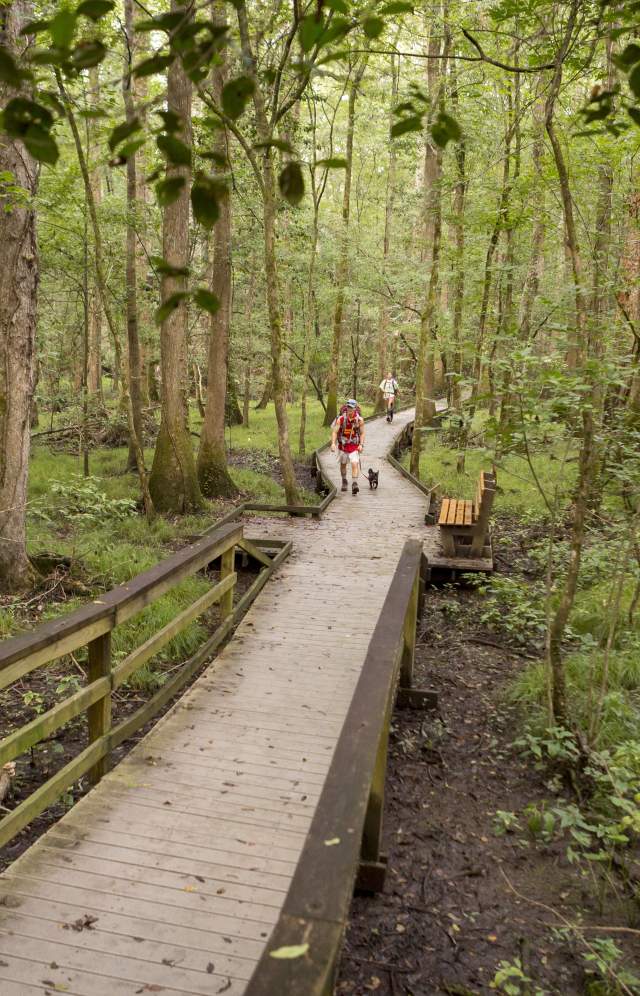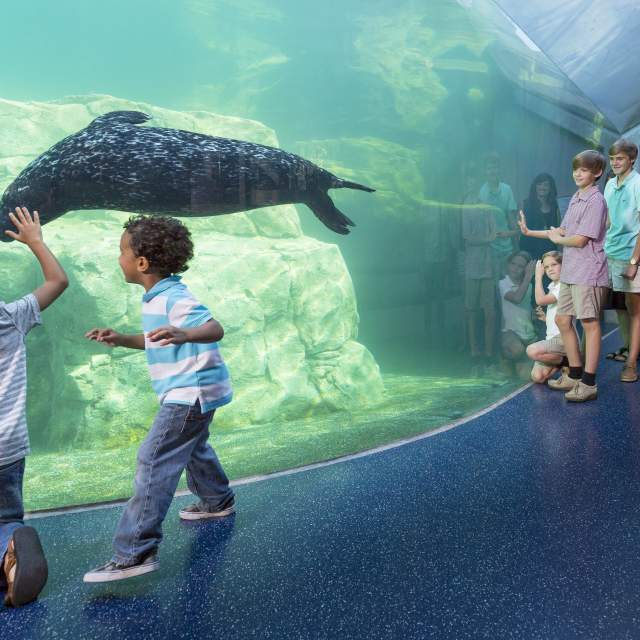Congaree National Park
Some national parks hold large animals and wide-spanning views that become crowded with visitors. Not Congaree National Park. Like the unique ecosystem it protects - an ancient alluvial floodplain so deep and dense that it provided safe shelter for slaves from nearby plantations as they made their first steps toward freedom - the park stands with regal stoicism as it awaits exploration.
At 26,000 acres, South Carolina’s only National Park is the largest intact tract of old-growth bottomland hardwood forest remaining in the U.S. The park contains some of the tallest trees in Eastern North America with one of the highest canopies in the world with broad bio-diversity.
Whether you're meandering along the boardwalk or giving yourself a bit more of a challenge take our insider tips and don't forget some water or the bug spray! If you need assistance planning your backcountry adventure, send an email to the park rangers, who are available seven days a week.
Trails
There are three ways to take in South Carolina's only national park. The first is to stroll the Boardwalk, a 2.4-mile loop that meanders through stands of massive bald cypress trees with their distinctive “knees,” over creeks that move so slowly they resemble a swamp (but, technically, are not) and past turtles, snakes, alligators, deer, woodpeckers, deer, wild pigs, river otters and even bobcats - some of which you will see, but many of which will be invisibly watching you. Wide, handicapped-accessible, and sturdy, the boardwalk allows exploration without getting dirty, wet, or lost - a bonus for the directionally challenged or parents of young children.
For a bit of adventure, hop off the boardwalk and hike a section of the Sims Trail, which runs from just past the Harry Hampton Visitor Center to Weston Lake, remaining within the boundaries of the boardwalk the entire time. Challenge yourself even more and hike into the park’s wilderness, an area of nearly 22,000 acres.
You’ll find about 25 miles of marked trails, but they’re primitive: one of the ways that Congaree National Park maintains a pristine environment for all the senses is by prohibiting power tools, which change the nature of the park with their noise and smell. For hikers, this means that when a huge tree falls across the trail, it’s often left there to be climbed over or walked around. Fast-growing plants and vines, thanks to the park’s nutrient-rich soil, also tend to spill into paths, necessitating long pants and proper hiking boots.
Water
The second is to take to the water: a marked, 6.6-mile canoe and kayak trail follows Cedar Creek as it twists and turns through the park’s northwestern sector. It’s a safe, but challenging, course, bursting with both low-key natural wonders - silent owls, slithery snakes, champion trees - and a bevy of obstacles that include vines, fallen trees, live trees, more cypress knees, and outstretched limbs. It’s quiet, but not, thanks to the steady hum birds, insects, frogs and creatures rustling through dry leaves.
You can explore on your own or participate in regularly-scheduled paddles led by the park’s team of rangers, who come armed with facts, stories, lore and history. It’s known, for instance, that runaway slaves set up communities within this unforgiving landscape, living “free” but remaining close to enslaved family members, who risked their lives to provide food and clothing until the family could be reunited. Later, during Prohibition, these deep woods attracted bootleggers, who found an easy place to hide their stills and, thanks to the river, transport their moonshine.
Camping
Camping is welcomed (and free) in the park, and the riverbank is a glorious natural campsite, particularly if you stumble onto a sandbar large enough for your tent. The four-or-so-mile Weston Lake Loop, for instance, leads to a point on Cedar Creek that just happens to be a favorite with river otters. The ten-mile long River Trail leads all the way to the Congaree River, a curling ribbon of placid water that forms the park’s more than 25-river-mile long southern border. Along the way, there are sandbars, ancient bluffs and all manner of wildlife. Camping is also permitted in the high-ground section of the park, where an actual campground means you can have a fire.
An easier way to catch a glimpse of the Congaree River is to hike the Bates Ferry Trail, a just-over one miler that opened in 2015 at the far eastern end of the park. The shady path leads to the site of Bates Ferry, which shuttled travelers across the river for decades.
However you choose to experience Congaree National Park, don’t forget to look up. The startlingly tall canopy, which changes with the seasons from summer’s green veil to the sunset shades of fall and, finally winter’s stark sculpture, is remarkable to behold.
Frequently Asked Questions
Is Congaree National Park worth visiting?
We think so! Just outside of the city, here you’ll be able to get some fresh air, connect with nature, and maybe get a little dirty. Bike, hike, camp, and explore South Carolina’s only national park – free of charge!
What is Congaree National Park known for?
Aside from the walking trails and the expansive nature, Congaree National Park is more commonly known for its yearly synchronous firefly movement. Worldwide there are over 2,000 species of fireflies and North America is home to three of those species that flash synchronously to find their special someone. They take up residence at one of the Southeast’s oldest forests every mid-May to mid-June. This phenom brings in thousands of people to the Columbia region and our minor league baseball team is named in their honor – let’s glow! Don’t think that’s the only thing, though. Congaree National Park holds the title of being home to the largest intact expanse of old-growth bottomland hardwood forest in the entire southeastern United States. Kayak along the river and see the webbing of multiple tree species and the animals that inhabit them. You’ll be nice and cool here, the old-growth forest forms one of the highest temperate deciduous forest canopies remaining in the world.
What is there to do at Congaree National Park?
At Congaree National Park, a lot of adventure is to be had.
Go for a short hike along the Boardwalk Trail, if you're looking for a challenge hike along the River Trail and see what wildlife you can spot. Bring your fishing license and pole to cast a line and see what will nibble. Canoe or kayak down Cedar Creek to experience the park from a different point of view. If you're looking to rent one of these small boats, you'll have to do it through a commercial outfitter such as Palmetto Outdoors or Carolina Outdoor Adventures. Keep your eye out for the park's calendar of events, the have park ranger led programs ranging from tours to yoga.
Having so much fun that you don't want to leave? Make a reservation to camp at either of the two frontcountry campgrounds, Longleaf Campground or Bluff Campground.
How much time do you need in Congaree National Park?
To maximize your time in Congaree National Park we suggest spending at least one day there. With many different trails that veer off into the forest, you’ll want to spend the morning exploring before a picnic then finish the day off with a canoe or kayak ride.
Are pets allowed at Congaree National Park?
Yes! Your furry friends need some fresh air too. If you choose to bring your pet along, they must be attended to and on a leash at all times. For the protection of you, your pet, and others, the maximum length of the leash is 6-feet. Don't forget the water bowls - it's hot out there!
What is the climate like at Congaree National Park?
The weather at Congaree National Park is reflective of Columbia SC weather. April - September temperatures can get pretty high, always be sure to check weather conditions when planning and to pack water and sunscreen. The parks lies within the floodplain of the Congaree River and occasional flooding can develop, if heavy rainfall occurs, we suggest checking with the park directly as trails may be closed off.
Will I see any animals while at Congaree National Park?
The park is home to a wide variety of mammals, amphibians, and reptiles that inhabit the water and woodland areas. While you're more likely to see a common cotton mouse or the non-venomous indigo snake, some alligators do live in deep parts of the Congaree River. These reptiles prefer to dwell in the water and sightings are fairly uncommon, if you have any concerns express them with the park ranger before your expedition! If you're lucky you'll see South Carolina's state animal - the white-tailed deer!
Are there alligators in Congaree National Park?
Yes, alligators occupy a variety of wetlands in the State of South Carolina, and Congaree National Park is no exception. These large reptiles typically keep to the swamp. Alligators are typically shy creatures, so just remember the same general rules you would while in any other natural habitat. Keep alert, do not feed the wildlife, properly dispose of your trash, follow directions on signs, and keep an eye on your children and pets.







